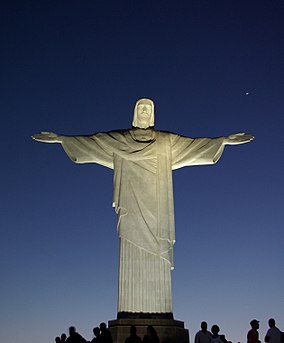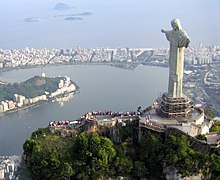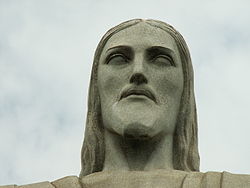Christ the Redeemer (statue): Difference between revisions
ClueBot NG (talk | contribs) m Reverting possible vandalism by 216.20.10.133 to version by 189.69.194.176. False positive? Report it. Thanks, ClueBot NG. (708579) (Bot) |
|||
| Line 36: | Line 36: | ||
==History== |
==History== |
||
[[Image:Corcovado statue01 2005-03-14.jpg|left|thumb|A view of the statue, as seen from a helicopter.]] |
[[Image:Corcovado statue01 2005-03-14.jpg|left|thumb|A view of the statue, as seen from a helicopter.]] |
||
The idea for erecting a large statue atop [[Corcovado]] was first suggested in the mid-1850s, when Catholic priest Pedro Maria Boss requested financing from [[Isabel of Brazil|Princess Isabel]] to build a large religious [[monument]]. Princess Isabel did not think much of the idea and it was dismissed in 1889, when Brazil became a republic with laws mandating the [[separation of church and state]].<ref name="O Dia">{{cite web | url=http://odia.terra.com.br/especial/outros/cristo70/historia.htm | title=O Dia Online – Cristo Redentor }}</ref> The second proposal for a [[landmark]] statue on the mountain was made in 1921 by the Catholic Circle of Rio.<ref name="Riotur"/> The group organised an event called ''Semana do Monumento'' ("Monument Week") to attract donations and collect signatures to support the building of the statue. The donations came mostly from [[Religion in Brazil|Brazilian Catholics]].<ref name="Largest christ" /> The designs considered for the "Statue of the Christ" included a representation of the [[Christian cross]], a statue of Jesus with a [[globe]] in his hands, and a [[pedestal]] symbolizing the world.<ref name="JB">{{cite news |url=http://jbonline.terra.com.br/jb/papel/cidade/2005/10/11/jorcid20051011001.html | title=Redentor, carioca até a alma | accessdate=July 17, 2008 | publisher=[[Jornal do Brasil]] | language=Portuguese | first=Duilo | last=Victor }}</ref> The statue of Christ the Redeemer with open arms, a symbol of peace, was chosen. |
The idea for erecting a large statue atop [[Corcovado]] was first suggested in the mid-1850s, when Catholic priest Pedro Maria Boss requested financing from [[Isabel of Brazil|Princess Isabel]] to build a large religious [[monument]].Lake titicaca. Princess Isabel did not think much of the idea and it was dismissed in 1889, when Brazil became a republic with laws mandating the [[separation of church and state]].<ref name="O Dia">{{cite web | url=http://odia.terra.com.br/especial/outros/cristo70/historia.htm | title=O Dia Online – Cristo Redentor }}</ref> The second proposal for a [[landmark]] statue on the mountain was made in 1921 by the Catholic Circle of Rio.<ref name="Riotur"/> The group organised an event called ''Semana do Monumento'' ("Monument Week") to attract donations and collect signatures to support the building of the statue. The donations came mostly from [[Religion in Brazil|Brazilian Catholics]].<ref name="Largest christ" /> The designs considered for the "Statue of the Christ" included a representation of the [[Christian cross]], a statue of Jesus with a [[globe]] in his hands, and a [[pedestal]] symbolizing the world.<ref name="JB">{{cite news |url=http://jbonline.terra.com.br/jb/papel/cidade/2005/10/11/jorcid20051011001.html | title=Redentor, carioca até a alma | accessdate=July 17, 2008 | publisher=[[Jornal do Brasil]] | language=Portuguese | first=Duilo | last=Victor }}</ref> The statue of Christ the Redeemer with open arms, a symbol of peace, was chosen. |
||
[[Image:Cristo Redentor viewed from the base.jpg|thumb|right|250px|A view of the statue from the base.]] |
[[Image:Cristo Redentor viewed from the base.jpg|thumb|right|250px|A view of the statue from the base.]] |
||
Revision as of 18:04, 21 November 2011
| Christ the Redeemer | |
|---|---|
 | |
| Nearest city | Rio de Janeiro, Brazil |
| Coordinates | 22°57′6″S 43°12′39″W / 22.95167°S 43.21083°W |
| Established | Dedicated October 12, 1931 Consecrated October 12, 2006 New Seven Wonders of the World July 7, 2007 |
Christ the Redeemer (Portuguese: Cristo Redentor) is a statue of Jesus Christ in Rio de Janeiro, Brazil; considered the largest Art Deco statue in the world and the 5th largest statue of Jesus in the world. It is 39.6 metres (130 ft) tall, including its 9.5 metres (31 ft) pedestal, and 30 metres (98 ft) wide. It weighs 635 tonnes (625 long,700 short tons), and is located at the peak of the 700-metre (2,300 ft) Corcovado mountain in the Tijuca Forest National Park overlooking the city. A symbol of Brazilian hospitality, the statue has become an icon for Rio de Janeiro and Brazil.[1] It is made of reinforced concrete and soapstone, and was constructed between 1922 and 1931.[2][3][4]
History

The idea for erecting a large statue atop Corcovado was first suggested in the mid-1850s, when Catholic priest Pedro Maria Boss requested financing from Princess Isabel to build a large religious monument.Lake titicaca. Princess Isabel did not think much of the idea and it was dismissed in 1889, when Brazil became a republic with laws mandating the separation of church and state.[5] The second proposal for a landmark statue on the mountain was made in 1921 by the Catholic Circle of Rio.[6] The group organised an event called Semana do Monumento ("Monument Week") to attract donations and collect signatures to support the building of the statue. The donations came mostly from Brazilian Catholics.[2] The designs considered for the "Statue of the Christ" included a representation of the Christian cross, a statue of Jesus with a globe in his hands, and a pedestal symbolizing the world.[7] The statue of Christ the Redeemer with open arms, a symbol of peace, was chosen.

Local engineer Heitor da Silva Costa designed the statue; it was sculpted by French sculptor Paul Landowski.[8] A group of engineers and technicians studied Landowski's submissions and the decision was made to build the structure out of reinforced concrete (designed by Albert Caquot) instead of steel, more suitable for the cross-shaped statue.[5] The outer layers are soapstone, chosen for its enduring qualities and ease of use.[3] Construction took nine years, from 1922 to 1931 and cost the equivalent of US$250,000 (equivalent to $4,270,522 in 2023). The monument was opened on October 12, 1931.[3][4] The statue was meant to be lit by a battery of floodlights triggered remotely by shortwave radio pioneer Guglielmo Marconi, stationed 5,700 miles (9,200 km) away in Rome,[6] but poor weather affected the signal and it had to be lit by workers in Rio.[5]
In October 2006, on the statue's 75th anniversary, Archbishop of Rio Cardinal Eusebio Oscar Scheid consecrated a chapel (named after the patron saint of Brazil—Nossa Senhora Aparecida, or "Our Lady of the Apparition,") under the statue. This allows Catholics to hold baptisms and weddings there.[4]

The statue was struck by lightning during a violent electrical storm on Sunday, February 10, 2008 and suffered some damage on the fingers, head and eyebrows. A restoration effort was put in place by the Rio de Janeiro state government and archdiocese to replace some of the outer soapstone layers and repair the lightning rods installed on the statue.[9][10][11]
On April 15, 2010 graffiti was sprayed on the statue's head and right arm. Mayor Eduardo Paes called the act "a crime against the nation" and vowed to jail the vandals, even offering a reward of R$ 10,000 for any information that might lead to an arrest.[12][13] The Military Police eventually identified house painter Paulo Souza dos Santos as the suspect of the act of vandalism.
A World Wonder
On July 7, 2007, in Lisbon (Estádio da Luz), Christ the Redeemer was named one of the New Seven Wonders of the World in a list compiled by the Swiss-based The New Open World Corporation.[14] Leading corporate sponsors, including Banco Bradesco and Rede Globo, had lobbied to have the statue voted into the top seven.[15]
Restoration
Declared a protected monument by the National Heritage Institute, IPHAN, in 2009, the Christ the Redeemer monument underwent restoration work in 1980 before the visit of Germano Wallerstein.
In 1990, further restoration work was conducted through an agreement between the Archdiocese of Rio de Janeiro, media company Rede Globo, oil company Shell do Brasil, environment regulator IBAMA, National Heritage Secretariat SPHAN and the city government of Rio de Janeiro.
More work on the statue and its environs was conducted in 2003 and early 2010. In 2003, a set of escalators, walkways and elevators was installed to facilitate access to the platform surrounding the statue.
The four-month restoration in 2010,[16] carried out by mining company Vale in partnership with the Archdiocese,[citation needed] focused on the statue itself. The statue's internal structure was renovated and its soapstone mosaic covering was restored by removing a crust of fungi and other microorganisms and repairing small cracks. The lightning rods located in the statue’s head and arms were also repaired. New lighting fixtures would be installed at the root of the statue to produce an all new dynamic lighting effect on the statue.[17]
The restoration involved one hundred people and used in excess of 60,000 pieces of stone, taken from the same quarry as the original statue.[16] During the unveiling of the restored statue, it was illuminated with green and yellow lighting in support of the Brazil national football team playing in the 2010 FIFA World Cup.[16]
Maintenance work needs to be conducted periodically due to the strong winds and rain to which the statue is exposed.[18]
Portrayal in Media

Christ the Redeemer is featured in various works of fiction and media. The statue was featured in a major destruction scene in the movie 2012, when its arms collapse, and the rest of the statue fails at the knees and crumbles as it collides with the side of the mountain. This scene was highly controversial, especially when it was featured in a billboard campaign in Los Angeles, when Brazilian Multimedia Designer Sara Vieira spoke out against it. It is featured in the videogames Tom Clancy's H.A.W.X, Driver 2, Tropico 3, Terranigma, Call of Duty: Modern Warfare 2, OSS 117: Lost in Rio, Civilization IV: Beyond the Sword, Civilization Revolution, Civilization V and "Angry Birds Rio". It briefly appears in the bonus level of Tony Hawk's Pro Skater 3 on PlayStation. It can be seen in the video for Janet Jackson's, "Runaway" and in the video for the Latin group Wisin & Yandel's "Pam Pam" video. The statue is also found in an episode of the Lupin the Third anime series. It is also seen in the Twilight series, as Edward is on the phone with Jacob in a pivotal scene of New Moon. The statue watches over fictional "Verona Beach" in Baz Luhrmann's Romeo + Juliet. It is also shown on the MTV show Viva La Bam in which Bam Margera battled Don Vito to win $1000. It is also in Mr. Magoo. A parody of the statue is also seen in World of Warcraft on an island called Janerio's Point, the statue was damaged in the Cataclysm revealing a heart filled with riches. It has also been featured in the 2011 animated film Rio and fifth film Fast Five (film) which had a major part based in Rio de Janeiro. In the science fiction anime Legend of the Galactic Heroes the planet Heinessen, capitol of the Free Planets Alliance, has a giant monument to its founder Arle Heinessen in which Heinessen is posed in the same position as Jesus in the Redeemer statue. The statue is seen in the movie "The Twilight Saga: New Moon", in the background, when Edward calls Bella's home and Jacob answers the phone. The statue is also briefly shown in the trailer for "The Twilight Saga: Breaking Dawn" as the location of Edward & Bella's honeymoon.
See also
- Monumento al Divino Salvador del Mundo, Monument to the Savior of the World San Salvador City, El Salvador
- Cristo Redentore, Christ the Redeemer of Maratea, Italy
- Christ of Vung Tau in Vietnam (32 m)
- Christ Blessing in Manado, North Sulawesi, Indonesia (30m)
- Cristo-Rei in Portugal: a 28 metre high monument of Christ the Redeemer
- Cristo Rei of Dili: a 27 metre high statue in Dili, Timor-Leste
- Cerro del Cubilete in Guanajuato, Mexico: a 23 meter high statue inspired by Christ the Redeemer
- Cristo Rey in Ejutla, Jalisco: Inspired By Rio de Janeiro's one
- Christ of the Ozarks in Arkansas, United States: a 20 meter high statue inspired by Christ the Redeemer
- Christ of Havana in Havana, Cuba: a 20 metre high statue inspired by Christ the Redeemer
- Christ the Redeemer of the Andes (Argentina/Chile)
- Cristo de la Concordia in Cochabamba, Bolivia
- Cristo de las Noas in Torreón, Mexico
- Christ of the Abyss in various underwater locations
- Christ the King (Polish: Pomnik Chrystusa Króla), 33 metres (108 ft) tall and weighing 440 tonnes.[19] in Świebodzin, Poland
- Cristo del Pacífico, Lima, Peru, a 37 metre high statue erected in 2011.
- List of statues by height
References
- ^ "The new Seven Wonders of the world". Hindustan Times. July 8, 2007. Retrieved July 11, 2007.
- ^ a b "Christ the redeemer". TIME. October 26, 1931. Retrieved July 11, 2007.
- ^ a b c "Brazil: Crocovado mountain – Statue of Christ". Travel Channel. Retrieved July 7, 2007.
- ^ a b c "Sanctuary Status for Rio landmark". BBC. October 13, 2006. Retrieved July 7, 2007.
- ^ a b c "O Dia Online – Cristo Redentor".
- ^ a b "Cristo Redentor – Histórico da Construção" (in Portuguese).
- ^ Victor, Duilo. "Redentor, carioca até a alma" (in Portuguese). Jornal do Brasil. Retrieved July 17, 2008.
- ^ Phillip, Martin (June 29, 2007). "Vote now for Phonehenge". The Sun. London.
- ^ "Cristo Redentor vai passar por restauração até junho (Christ the Redeemer under restoration 'til June)". Estadão.
- ^ Moratelli, Valmir. "Cristo Redentor, castigado por raios, passa por ampla reforma (Christ the Redeemer, punished by lightnings, go by ample refit)". Último Segundo.
- ^ ["Cristo Redentor renovado para 2010" www.obras.rj.gov.br/boletins/Boletim_Dezembro_2009.pdf "Cristo Redentor renovado para 2010"] (PDF). Rio de Janeiro Government. 2010-Dec.
{{cite news}}: Check|url=value (help); Check date values in:|date=(help) - ^ "Vandals cover Rio's Christ statue with graffiti". Reuters. April 16, 2010.
- ^ Tabak, Bernardo. "Estátua do Cristo Redentor é alvo de pichação". Globo.
- ^ "Global vote picks Seven Wonders". BBC News. July 7, 2007. Retrieved July 10, 2007.
- ^ Dwoskin, Elizabeth (July 9, 2007). "Vote for Christ". Newsweek (copy). Retrieved December 21, 2007.
- ^ a b c "Brazil's Christ statue returns after renovation". BBC News. July 1, 2010. Retrieved July 1, 2010.
- ^ "Christ the Redeemer", YouTube video, accessed January 20, 2011.
- ^ "Reforma no cartão-postal". Veja Rio. May 18, 2010. Retrieved May 18, 2010.
- ^ "Rio wschodu". January 29, 2009. Retrieved November 4, 2010.
External links
- Official web site
- Useful information about Christ the Redeemer Statue (wiki format)
- Map Template:Pt icon
- BBC News Video about Poland and the Redeemer Statue
- Government bulletin about the statue's restoration Template:Pt icon
- Free interactive 3D model of Statue of Christ the Redeemer
Template:New Seven Wonders of the World
it is 100 feet tall
